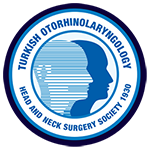ABSTRACT
Objectives:
The aim of the study is to investigate the long term effects of stapedotomy on hearing threshold differences in patients with otosclerosis, and also the effects of the pistons with the diameter of 0.4 mm and 0.6 mm on hearing.
Methods:
In this study, 220 patients that had stapedotomy between 1996 and 2000 are retrospectively evaluated.
Results:
148 out of 220 patients (67.2%) had their air-bone gap between 0-10 dB, 64 patients (29%) between 10-20 dB, and 8 patients (3.6%) above 20 dB. There wasn’t any statistically significant difference in speech discrimination scores in pre- and postoperative period. Furthermore, there was no statistical difference in the outcome of the pistons’ diameters used in stapedetomy. Basing the findings of the average postoperative air bone gap, a low 3.6% failure rate suggests that the stapedotomy is the preferred method in the otoscleroris surgery.
Conclusion:
The results of this study suggest that stapedotomy technique yields successful results in otosclerosis findings independent of the radius of the used piston.
ÖZET
Amaç:
Otoskleroz cerrahisi için stapedotomi operasyonu yapılan hastalarda, uygulanan cerrahi girişimin uzun dönemde işitme eşiklerinde oluşturduğu değişikliklerin araştırılması amaçlanmış; kullanılan 0.4 mm ve 0.6 mm'lik pistonların işitmeye olan etkileri karşılaştırmıştır.
Yöntem:
Bu çalışmada 1996-2000 yılları arasında stapedotomi uygulanan 220 otoskleroz olgusu retrospektif olarak değerlendirilmiştir.
Bulgular:
220 olgunun 148'inde (%67.2) hava-kemik aralığı 0-10 dB arasında, 64'ünde (%29) hava-kemik aralığı 10-20 dB arasında, 8'in-de (%3.6) hava-kemik aralığı 20 dB'in üzerinde saptandı. Hiçbir olguda preoperatif ve postoperatif speech diskriminasyon skorları arasında istatistiksel olarak anlamlı bir fark gözlenmemiştir. Stapedotomi operasyonu sırasında kullanılan pistonlar karşılaştırıldığında, 0.4 mm ve 0.6 mm'lik piston kullanılan olguların sonuçları arasında istatistiksel olarak anlamlı bir fark bulunmamıştır. Çalışmamızdaki bulguların postoperatif hava yolu ortalaması - postoperatif kemik yolu ortalaması esas alınarak değerlendirilmesinde %3.6 gibi düşük bir başarısızlık oranının çıkması, stapedotomi yönteminin otoskleroz cerrahisinde tercih edilebilecek bir teknik olduğunu göstermektedir.
Sonuç:
Bu çalışmada elde edilen sonuçlar stapedotomi tekniğinin, kullanılan piston çapına bağlı olmaksızın otoskleroz olgularında başarılı sonuçlar verdiğini destekler niteliktedir.



